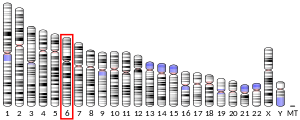TFAP2B
Transcription factor AP-2 beta also known as AP2-beta is a protein that in humans is encoded by the TFAP2B gene.[5][6]
Function
AP-2 beta is a member of the AP-2 family of transcription factors. AP-2 proteins form homo- or hetero-dimers with other AP-2 family members and bind specific DNA sequences. They are thought to stimulate cell proliferation and suppress terminal differentiation of specific cell types during embryonic development. Specific AP-2 family members differ in their expression patterns and binding affinity for different promoters. This protein functions as both a transcriptional activator and repressor.[7]
Clinical significance
Mutations in this gene result in autosomal dominant Char syndrome, suggesting that this gene functions in the differentiation of neural crest cell derivatives.[7]
References
- GRCh38: Ensembl release 89: ENSG00000008196 - Ensembl, May 2017
- GRCm38: Ensembl release 89: ENSMUSG00000025927 - Ensembl, May 2017
- "Human PubMed Reference:". National Center for Biotechnology Information, U.S. National Library of Medicine.
- "Mouse PubMed Reference:". National Center for Biotechnology Information, U.S. National Library of Medicine.
- Moser M, Imhof A, Pscherer A, Bauer R, Amselgruber W, Sinowatz F, Hofstädter F, Schüle R, Buettner R (1 September 1995). "Cloning and characterization of a second AP-2 transcription factor: AP-2 beta". Development. 121 (9): 2779–88. PMID 7555706.
- Williamson JA, Bosher JM, Skinner A, Sheer D, Williams T, Hurst HC (July 1996). "Chromosomal mapping of the human and mouse homologues of two new members of the AP-2 family of transcription factors". Genomics. 35 (1): 262–4. doi:10.1006/geno.1996.0351. PMID 8661133.
- "Entrez Gene: transcription factor AP-2 beta (activating enhancer binding protein 2 beta)".
Further reading
- Tsukada S, Tanaka Y, Maegawa H, et al. (2006). "Intronic polymorphisms within TFAP2B regulate transcriptional activity and affect adipocytokine gene expression in differentiated adipocytes". Mol. Endocrinol. 20 (5): 1104–11. doi:10.1210/me.2005-0311. PMID 16373396.
- Stelzl U, Worm U, Lalowski M, et al. (2005). "A human protein-protein interaction network: a resource for annotating the proteome". Cell. 122 (6): 957–68. doi:10.1016/j.cell.2005.08.029. hdl:11858/00-001M-0000-0010-8592-0. PMID 16169070.
- Lindgren CM, Heid IM, Randall JC, et al. (2009). Allison DB (ed.). "Genome-Wide Association Scan Meta-Analysis Identifies Three Loci Influencing Adiposity and Fat Distribution". PLOS Genet. 5 (6): e1000508. doi:10.1371/journal.pgen.1000508. PMC 2695778. PMID 19557161.
- Nordquist N, Göktürk C, Comasco E, et al. (2009). "The transcription factor TFAP2B is associated with insulin resistance and adiposity in healthy adolescents". Obesity (Silver Spring). 17 (9): 1762–7. doi:10.1038/oby.2009.83. PMID 19325541.
- Prichard ZM, Jorm AF, Mackinnon A, Easteal S (2007). "Association analysis of 15 polymorphisms within 10 candidate genes for antisocial behavioural traits". Psychiatr. Genet. 17 (5): 299–303. doi:10.1097/YPG.0b013e32816ebc9e. PMID 17728669.
- Michelon L, Meira-Lima I, Cordeiro Q, et al. (2006). "Association study of the INPP1, 5HTT, BDNF, AP-2beta and GSK-3beta GENE variants and retrospectively scored response to lithium prophylaxis in bipolar disorder". Neurosci. Lett. 403 (3): 288–93. doi:10.1016/j.neulet.2006.05.001. PMID 16787706.
- Fogu G, Bandiera P, Cambosu F, et al. (2007). "Pure partial trisomy of 6p12.1-p22.1 secondary to a familial 12/6 insertion in two malformed babies". Eur J Med Genet. 50 (2): 103–11. doi:10.1016/j.ejmg.2006.11.002. PMID 17185054.
- Hensch T, Wargelius HL, Herold U, et al. (2008). "Electrophysiological and behavioral correlates of polymorphisms in the transcription factor AP-2beta coding gene". Neurosci. Lett. 436 (1): 67–71. doi:10.1016/j.neulet.2008.02.062. PMID 18358611.
- Khetyar M, Syrris P, Tinworth L, et al. (2008). "Novel TFAP2B mutation in nonsyndromic patent ductus arteriosus". Genet. Test. 12 (3): 457–9. doi:10.1089/gte.2008.0015. PMID 18752453.
- Kimura K, Wakamatsu A, Suzuki Y, et al. (2006). "Diversification of transcriptional modulation: Large-scale identification and characterization of putative alternative promoters of human genes". Genome Res. 16 (1): 55–65. doi:10.1101/gr.4039406. PMC 1356129. PMID 16344560.
- Dagle JM, Lepp NT, Cooper ME, et al. (2009). "Determination of Genetic Predisposition to Patent Ductus Arteriosus in Preterm Infants". Pediatrics. 123 (4): 1116–23. doi:10.1542/peds.2008-0313. PMC 2734952. PMID 19336370.
- Ding X, Fan C, Zhou J, et al. (2006). "GAS41 interacts with transcription factor AP-2beta and stimulates AP-2beta-mediated transactivation". Nucleic Acids Res. 34 (9): 2570–8. doi:10.1093/nar/gkl319. PMC 3303177. PMID 16698963.
- Eckert D, Buhl S, Weber S, et al. (2005). "The AP-2 family of transcription factors". Genome Biol. 6 (13): 246. doi:10.1186/gb-2005-6-13-246. PMC 1414101. PMID 16420676.
- Fujimori K, Urade Y (2007). "Cooperative activation of lipocalin-type prostaglandin D synthase gene expression by activator protein-2beta in proximal promoter and upstream stimulatory factor 1 within intron 4 in human brain-derived TE671 cells". Gene. 397 (1–2): 143–52. doi:10.1016/j.gene.2007.04.029. PMID 17574780.
- Ebauer M, Wachtel M, Niggli FK, Schäfer BW (2007). "Comparative expression profiling identifies an in vivo target gene signature with TFAP2B as a mediator of the survival function of PAX3/FKHR". Oncogene. 26 (51): 7267–81. doi:10.1038/sj.onc.1210525. PMID 17525748.
- Nilsson KW, Damberg M, Ohrvik J, et al. (2007). "Genes encoding for AP-2beta and the Serotonin Transporter are associated with the Personality Character Spiritual Acceptance". Neurosci. Lett. 411 (3): 233–7. doi:10.1016/j.neulet.2006.10.051. PMID 17123722.
- Ikeda K, Maegawa H, Ugi S, et al. (2006). "Transcription factor activating enhancer-binding protein-2beta. A negative regulator of adiponectin gene expression". J. Biol. Chem. 281 (42): 31245–53. doi:10.1074/jbc.M605132200. PMID 16954217.
- Deng WG, Jayachandran G, Wu G, et al. (2007). "Tumor-specific activation of human telomerase reverses transcriptase promoter activity by activating enhancer-binding protein-2beta in human lung cancer cells". J. Biol. Chem. 282 (36): 26460–70. doi:10.1074/jbc.M610579200. PMID 17630431.
- Nilsson KW, Sjöberg RL, Leppert J, et al. (2009). "Transcription factor AP-2 beta genotype and psychosocial adversity in relation to adolescent depressive symptomatology". J Neural Transm. 116 (3): 363–70. doi:10.1007/s00702-009-0183-3. PMID 19184334.
- Maeda S, Tsukada S, Kanazawa A, et al. (2005). "Genetic variations in the gene encoding TFAP2B are associated with type 2 diabetes mellitus". J. Hum. Genet. 50 (6): 283–92. doi:10.1007/s10038-005-0253-9. PMID 15940393.
External links
- TFAP2B+protein,+human at the US National Library of Medicine Medical Subject Headings (MeSH)
- GeneReviews/NCBI/NIH/UW entry on Char Syndrome
This article incorporates text from the United States National Library of Medicine, which is in the public domain.



